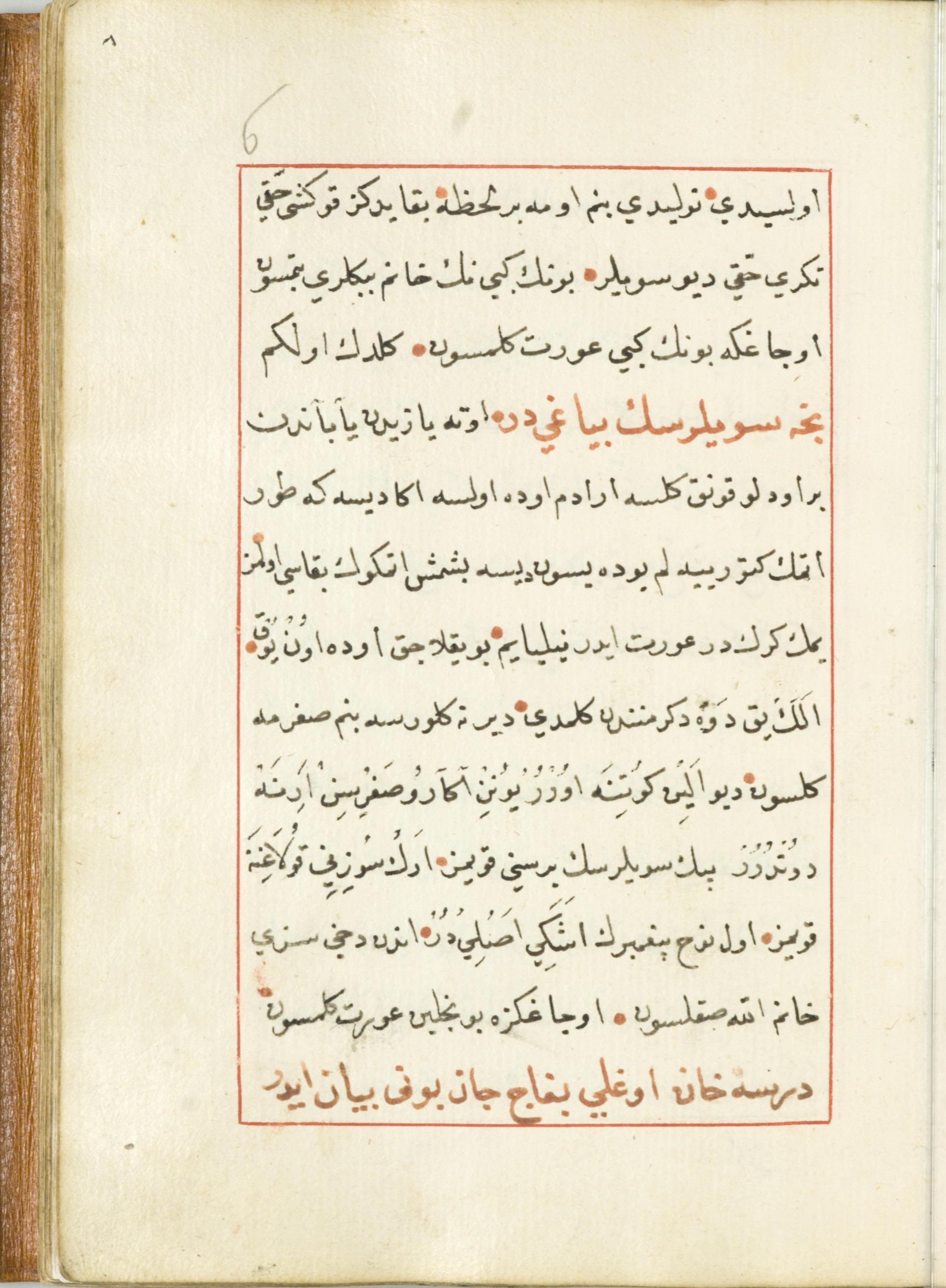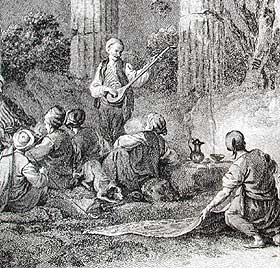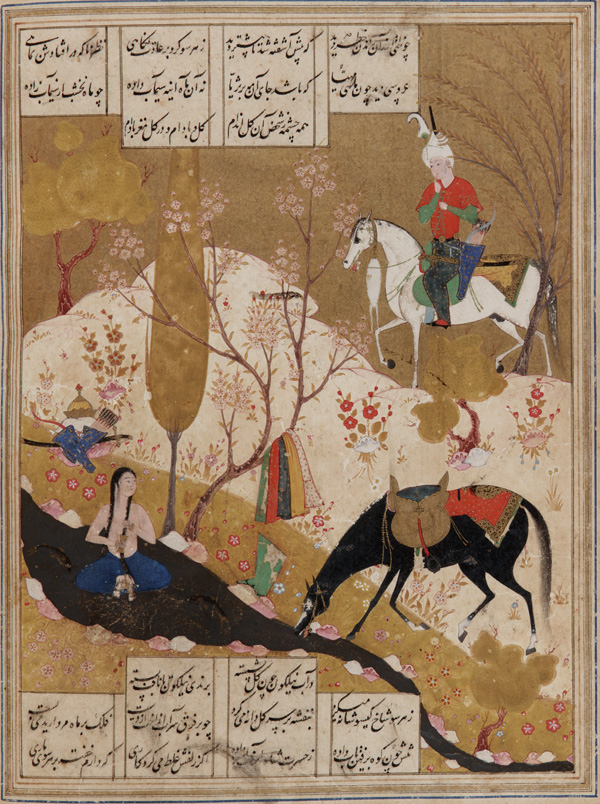|
Mehri And Vafa
Mehri and Vafa is one of the first works written in Azerbaijani language, written by Ummi Isa. The language of the poem is distinguished by its simplicity and comprehensibility, as it is written in a folkloric, colloquial language. Service to the poem "Book of Dede Korkut" and "Dastani-Ahmed Harami" "Mehri va Vafa" is written in a simpler language and is a development form for the modern reader to understand. The language of the poem is dominated by words of Turkish origin. Its grammatical structures differ only slightly from modern Azerbaijani. Research "Mehri and Vafa", a love story with two protagonists, has common characteristics in Turkish and Iranian literature. The story, which takes its source from Iranian literature, tells about lovers meeting each other after various events and obstacles, as the theme of a classical masnavi. One of the poets of the 9th century, Arshi Dahlavi and his brother Mir Mahammad Momini Arsh have poems called "Mehri va Vafa". A copy of Mir Muhamm ... [...More Info...] [...Related Items...] OR: [Wikipedia] [Google] [Baidu] |
Azerbaijani Language
Azerbaijani ( ; , , ) or Azeri ( ), also referred to as Azerbaijani Turkic or Azerbaijani Turkish (, , ), is a Turkic languages, Turkic language from the Oghuz languages, Oghuz sub-branch. It is spoken primarily by the Azerbaijanis, Azerbaijani people, who live mainly in the Azerbaijan, Republic of Azerbaijan, where the North Azerbaijani Variety (linguistics), variety is spoken, while Iranian Azerbaijanis in the Azerbaijan (Iran), Azerbaijan region of Iran, speak the South Azerbaijani Variety (linguistics), variety. Azerbaijani is the only official language in the Republic of Azerbaijan and one of the 14 official languages of Dagestan (a Federal subjects of Russia, federal subject of Russia), but it does not have official status in Iran, where the majority of Iranian Azerbaijanis, Iranian Azerbaijani people live. Azerbaijani is also spoken to lesser varying degrees in Azerbaijani communities of Georgia (country), Georgia and Turkey and by Azerbaijani diaspora, diaspora communi ... [...More Info...] [...Related Items...] OR: [Wikipedia] [Google] [Baidu] |
Ummi Isa
Ummi Isa ( Azerbaijani:''Ümmü İsa'') was the author of one of the earliest works written in Azerbaijani Turkish, the first narrative "Mehri and Vafa" in Turkic literature. According to the opinions of some researchers, Ummi Isa is considered the first poet to write in Azerbaijani Turkish. Life Although it is known that Ummi Isa lived in the 14th century, precise birth and death years remain unknown. Professor Yaqub Babayev, based on the linguistic features and poetic linguistics of the poems attributed to Ummi Isa, has written that he lived in the 13th-14th centuries. Another literary scholar, Amil Chalabioglu, has also written that Ummi Isa lived in the 14th century. He deduced this from the information provided at the end of one of Isa's works, stating that he lived in the years 1372-1373. On the other hand, Agah Sirri asserts that Isa lived in the 15th century and did not receive a good education based on the feelings expressed in his poems. Creativity "The sole surviving ... [...More Info...] [...Related Items...] OR: [Wikipedia] [Google] [Baidu] |
Book Of Dede Korkut
The ''Book of Dede Korkut'' or ''Book of Korkut Ata'' (, ; ; ) is the most famous among the dastans or epic stories of the Oghuz Turks. The stories carry morals and values significant to the social lifestyle of the nomadic Turkic peoples and their pre-Islamic beliefs. The book's mythic narrative is part of the cultural heritage of the peoples of Oghuz origin, mainly of Azerbaijan, Turkey and Turkmenistan. Only two manuscripts of the text, one in the Vatican and one in Dresden, Germany, were known before a third manuscript was discovered in a private collection in Gonbad-e Kavus, Iran, in 2018. The epic tales of ''Dede Korkut'' are some of the best-known Turkic dastans from among a total of well over 1000 recorded epics among the Turkic and Mongolian language families. Origin and synopsis of the epic ''Dede Korkut'' is a heroic dastan, also known as the ''Oghuznama'' among the Oghuz, which starts in Central Asia, continues in Anatolia, and centers most of its action in the ... [...More Info...] [...Related Items...] OR: [Wikipedia] [Google] [Baidu] |
Iranian Literature
Iranian literature, or Iranic literature, refers to the literature, literary traditions of the Iranian languages, developed predominantly in Iran and other regions in the Middle East and the Caucasus, eastern Anatolia, Asia Minor, and parts of western Central Asia and northwestern South Asia. These include works attested from as early as the 6th century BC. Modern Iranian literatures include Persian literature, Ossetian literature, Kurdish literature, Pashto literature and poetry, Pashto literature, and Balochi literature, among others. Classical and medieval eras Avestan The earliest surviving literary works in an Iranian language are that of the religious texts of the Avesta, written in Avestan, an Iranian languages#Old Iranian, Old Iranian sacred language. The oldest part of these are the Gathas (, , "hymn"), that are a collection of hymns believed to be composed by Zoroaster, the reformer of the ancient Iranian religion and the founder of Zoroastrianism, dating to the 6t ... [...More Info...] [...Related Items...] OR: [Wikipedia] [Google] [Baidu] |
Persian Language
Persian ( ), also known by its endonym and exonym, endonym Farsi (, Fārsī ), is a Western Iranian languages, Western Iranian language belonging to the Iranian languages, Iranian branch of the Indo-Iranian languages, Indo-Iranian subdivision of the Indo-European languages. Persian is a pluricentric language predominantly spoken and used officially within Iran, Afghanistan, and Tajikistan in three mutual intelligibility, mutually intelligible standard language, standard varieties, respectively Iranian Persian (officially known as ''Persian''), Dari, Dari Persian (officially known as ''Dari'' since 1964), and Tajik language, Tajiki Persian (officially known as ''Tajik'' since 1999).Siddikzoda, S. "Tajik Language: Farsi or not Farsi?" in ''Media Insight Central Asia #27'', August 2002. It is also spoken natively in the Tajik variety by a significant population within Uzbekistan, as well as within other regions with a Persianate society, Persianate history in the cultural sphere o ... [...More Info...] [...Related Items...] OR: [Wikipedia] [Google] [Baidu] |
Turkish Language
Turkish ( , , also known as 'Turkish of Turkey') is the most widely spoken of the Turkic languages, a member of Oghuz languages, Oghuz branch with around 90 million speakers. It is the national language of Turkey and one of two official languages of Cyprus. Significant smaller groups of Turkish speakers also exist in Germany, Austria, Bulgaria, North Macedonia, Greece, other parts of Europe, the South Caucasus, and some parts of Central Asia, Iraqi Turkmen, Iraq, and Syrian Turkmen, Syria. Turkish is the List of languages by total number of speakers, 18th-most spoken language in the world. To the west, the influence of Ottoman Turkish language, Ottoman Turkish—the variety of the Turkish language that was used as the administrative and literary language of the Ottoman Empire—spread as the Ottoman Empire expanded. In 1928, as one of Atatürk's reforms in the early years of the Republic of Turkey, the Persian alphabet, Perso-Arabic script-based Ottoman Turkish alphabet was repl ... [...More Info...] [...Related Items...] OR: [Wikipedia] [Google] [Baidu] |
Turkish Literature
Turkish literature () comprises oral compositions and written texts in the Turkish language. The Ottoman form of Turkish, which forms the basis of much of the written corpus, was highly influenced by Persian and Arabic literature,Bertold Spuler''Persian Historiography & Geography''Pustaka Nasional Pte Ltd p 69 and used the Ottoman Turkish alphabet. The history of the broader Turkic literature spans a period of nearly 1,300 years. The oldest extant records of written Turkic are the Orhon inscriptions, found in the Orhon River valley in central Mongolia and dating to the 7th century. Subsequent to this period, between the 9th and 11th centuries, there arose among the nomadic Turkic peoples of Central Asia a tradition of oral epics, such as the '' Book of Dede Korkut'' of the Oghuz Turks— ancestors of the modern Turkish people—and the '' Epic of Manas'' of the Kyrgyz people. Beginning with the victory of the Seljuks at the Battle of Manzikert in the late 11th centu ... [...More Info...] [...Related Items...] OR: [Wikipedia] [Google] [Baidu] |
Hijri Year
The Hijri year () or era () is the era used in the Islamic lunar calendar. It begins its count from the Islamic New Year in which Muhammad and his followers migrated from Mecca to Yathrib (now Medina) in 622 CE. This event, known as the Hijrah, is commemorated in Islam for its role in the founding of the first Muslim community (''ummah''). Currently, the Hijri year is . In the West, this era is most commonly denoted as AH (, , ) in parallel with the Christian/Common (AD/CE) and Jewish eras (AM) and can similarly be placed before (preferably) or after the date. In predominantly Muslim countries, it is also commonly abbreviated H ("Hijra") from its Arabic abbreviation (). Years prior to AH 1 are reckoned in English as BH ("Before the Hijra"), which should follow the date. A year in the Islamic lunar calendar consists of twelve lunar months and has only 354 or 355 days in its year. Consequently, its New Year's Day occurs ten days earlier each year relative to the Gregorian ... [...More Info...] [...Related Items...] OR: [Wikipedia] [Google] [Baidu] |
Nizami Ganjavi
Nizami Ganjavi (; c. 1141 – 1209), Nizami Ganje'i, Nizami, or Nezāmi, whose formal name was Jamal ad-Dīn Abū Muḥammad Ilyās ibn-Yūsuf ibn-Zakkī,Mo'in, Muhammad(2006), "Tahlil-i Haft Paykar-i Nezami", Tehran.: p. 2: Some commentators have mentioned his name as “Ilyas the son of Yusuf the son of Zakki the son of Mua’yyad” while others have mentioned that Mu’ayyad is a title for Zakki. Mohammad Moin, rejects the first interpretation claiming that if it were to mean 'Zakki son of Muayyad' it should have been read as 'Zakki i Muayyad' where izafe (-i-) shows the son-parent relationship but here it is 'Zakki Muayyad' and Zakki ends in silence/stop and there is no izafe (-i-). Some may argue that izafe is dropped due to meter constraints but dropping parenthood izafe is very strange and rare. So it is possible that Muayyad was a sobriquet for Zaki or part of his name (like Muayyad al-Din Zaki). This is supported by the fact that later biographers also state Yusuf was ... [...More Info...] [...Related Items...] OR: [Wikipedia] [Google] [Baidu] |
Haft Peykar
''Haft Peykar'' (), also known as ''Bahramnameh'' (, ''The Book of Bahram'', referring to the Sasanian emperor Bahram V), is a romantic epic poem by Persian poet Nizami Ganjavi, written in 1197. This poem is one of his five works known collectively as '' Khamsa'' ("Quintet"). The title ''Haft Peykar'' can be translated literally as "Seven Portraits", with the figurative meaning "Seven Beauties". Both translations are meaningful, and the poet probably made use of this ambiguity intentionally. The poem was dedicated to the Ahmadili ruler of Maragheh, Ala-al-Din Korpe Arslan bin Aq-Sonqor. Iranologist François de Blois writes, "Nezami’s ''Haft peykar'' is a masterpiece of erotic literature, but it is also a profoundly moralistic work." Around the time ''Haft Peykar'' was written, there were various styles in which Persian lyric poetry was presented and written. The style found in Haft Peykar is that of epic literature, where characters change moods and express complex feelin ... [...More Info...] [...Related Items...] OR: [Wikipedia] [Google] [Baidu] |
Institute Of Manuscripts Of Azerbaijan
Institute of Manuscripts (), named after Muhammad Fuzuli, is a scientific center of the Azerbaijan National Academy of Sciences engaged in scientific-research, archive and library science activities, security, study, translation and publication of medieval manuscripts. The institute is located in the building of the former Empress Alexandra Russian Muslim Boarding School for Girls, established in 1901 by H.Z.Taghiyev on Istiglaliyyat Street and designed by the Polish architect Józef Gosławski. History In 1924, during the All-Azerbaijani Regional Congress held in Baku, it was decided to found a scientific library with a special department dedicated to ancient manuscripts and rare books. Initially, the library was a part of the Research Union of Azerbaijan, but later it was included in the Nizami Institute for Literature. In 1950, the Republican Manuscript Foundation was established under the National Academy of Sciences of Azerbaijan. In 1986, the Institute of Manuscripts ... [...More Info...] [...Related Items...] OR: [Wikipedia] [Google] [Baidu] |
Atatürk University
Atatürk University () is a public land-grant research university established in 1957 in Erzurum, Turkey, in collaboration with the University of Nebraska. The university comprises 23 faculties, 18 colleges, 8 institutes, and 30 research centers. The university's main campus is located in Erzurum, one of the largest cities in Eastern Anatolia, and is considered one of the city's most prominent assets. Since its founding, the university has been a center of educational and cultural development for the eastern region of Turkey. History The establishment of Atatürk University represents the fulfillment of one of the significant initiatives envisioned during the early years of the Turkish Republic. On November 1, 1937, in his opening address for the legislative year at the Grand National Assembly of Turkey, Mustafa Kemal Atatürk emphasized the need for a major university in Eastern Anatolia. He called for the necessary steps to be taken to realize this vision. Following Atat� ... [...More Info...] [...Related Items...] OR: [Wikipedia] [Google] [Baidu] |





